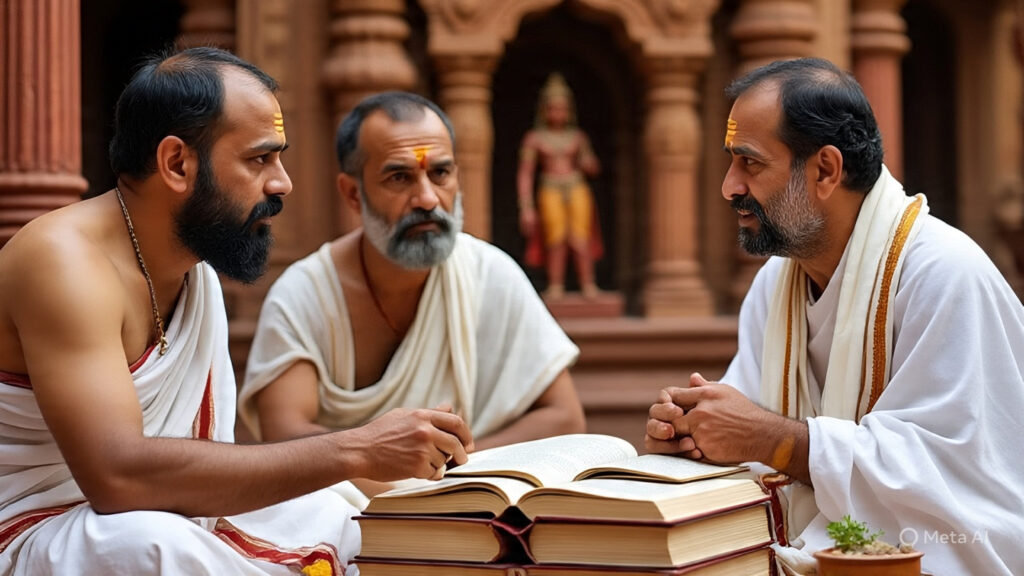What are pramāṇa?
Pramāṇa (proof of knowledge) are evidence, proof and hypothesis testing methodologies developed in ancient India. Importantly, this is a testament to the fact that knowledge in ancient Bhārat was driven by focus on integrity and truth.
What are the various pramāṇa?
There are six pramāṇa. These are – pratyakṣa (personal vision or experience of logic), anumāna (inference through application of rules of nature), upamāna (comparison and analogy with various logical constructs that have been accepted as valid), arthāpatti (postulation and derivation from evidence), anupalabdhi (non-apprehension or negative cognitive proof) and śabda (verbal testimony).
Pratyakṣa or personal experience.
Significantly, this is the most effective source of proof because it is based on personal experience.
 Example: Firstly, assume that you are walking down a street and see someone walking unsteadily in front of you. Generally, you would thing that he is drunk and feel disgusted. However, as you overtake him, if you were to see that the person is ill or in pain, your attitude would change immediately.
Example: Firstly, assume that you are walking down a street and see someone walking unsteadily in front of you. Generally, you would thing that he is drunk and feel disgusted. However, as you overtake him, if you were to see that the person is ill or in pain, your attitude would change immediately.
Any change in perception has been brought about by personal experience in the situation is pratyakṣa or personal experience.
Anumāna or inference from experience.
This is the drawing of a conclusion based on prior knowledge, like assuming that if there is smoke, there must be fire.
Example: Assume that you are a parent whose child has been consistently getting good marks and grades. However, if in one exam, the child’s marks were to deteriorate unexpectedly, you would rightly assume from experience that the situation needs investigation. This is anumāna or inference drawn from experience.
Upamāna or comparison based on experience.
Example: We know that domestic dogs are similar to street dogs because we compare their form and function. Consequently, when we go on a wild life safari, we are able to recognise wolves, foxes or hyenas as different from dogs.
This ability to compare and conclude is upamāna or comparison from experience.
Arthāpatti or postulation derived from evidence.
Example: Importantly, all businesses create forecasts based on prior performance and future potential. Furthermore, these projections are based on analysis of prior performance, examination of current business situation, resources and risk.
Also, the accuracy of any forecast depends on the analyst’s experience and exposure to various aspects of the business being forecasted.
This is arthāpatti or postulation derived from evidence.
Anupalabdhi or negative cognitive proof.
Anupalabdhi is the ability to recognise a missing aspect of any problem being analysed.
Example: Assume that you are collating all your documents for an interview and you find your birth certificate missing.
Since, you recognise the absence of the certificate, you will initiate a search. This is anupalabdhi or negative cognitive proof.
Sabda or verbal testimony.
This is a commonly used pramāṇa or proof of existence.
Example: You are a manager with many sales representatives reporting to you. While, you may go with a few on customer visits, you will rely on verbal inputs or sabda of your subordinates to assess the state of your operations.
Conclusion: Importantly, one can see that Bhārat’s ancient dhārmic system does not prescribe, it allows one to seek, make mistakes, correct in small and incremental steps. This is called anubhava or experience, and enables the practitioner to reach the truth or state of Brahman.
Obviously, to reach the Truth, the aspirant needs to have enormous drive, persistence and patience (śraddhā) to overcome frustration and failure.
Additionally, since the path is driven by cognitive proof, aspirant can choose from multiple paths in a manner that aligns with his or her personality.
Furthermore, when the aspirant is able to do this, then he or she is able to transcend illusion and reaches a state of cognitive perfection, the state of Truth or Brahman.
Interestingly, this Truth is enshrined in the Indian constitution as “Truth will triumph” (satyameva-jayate).


